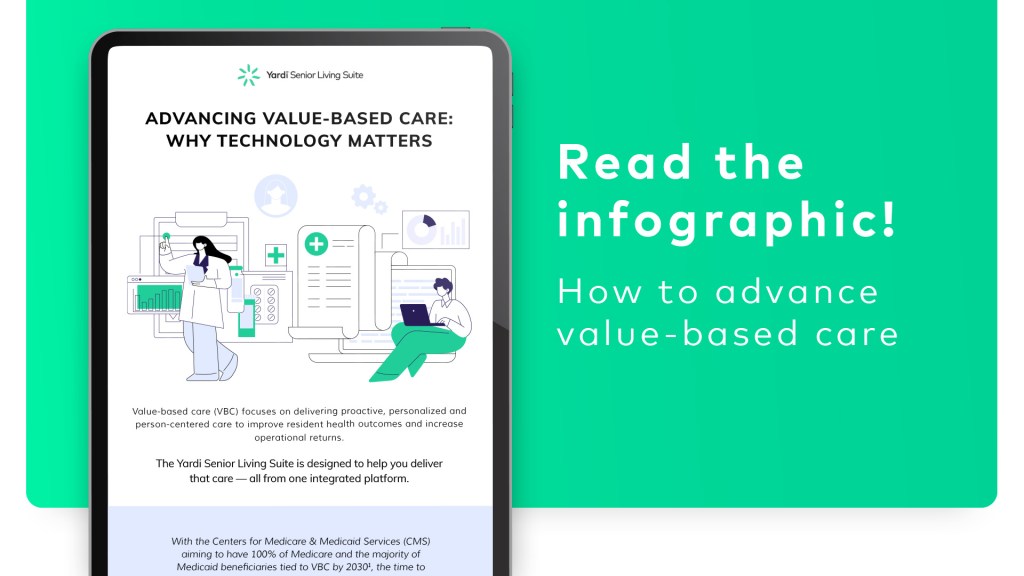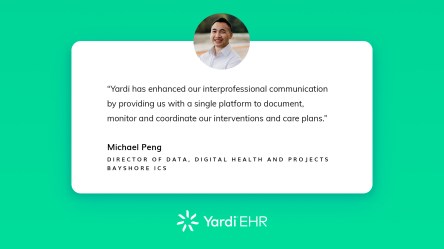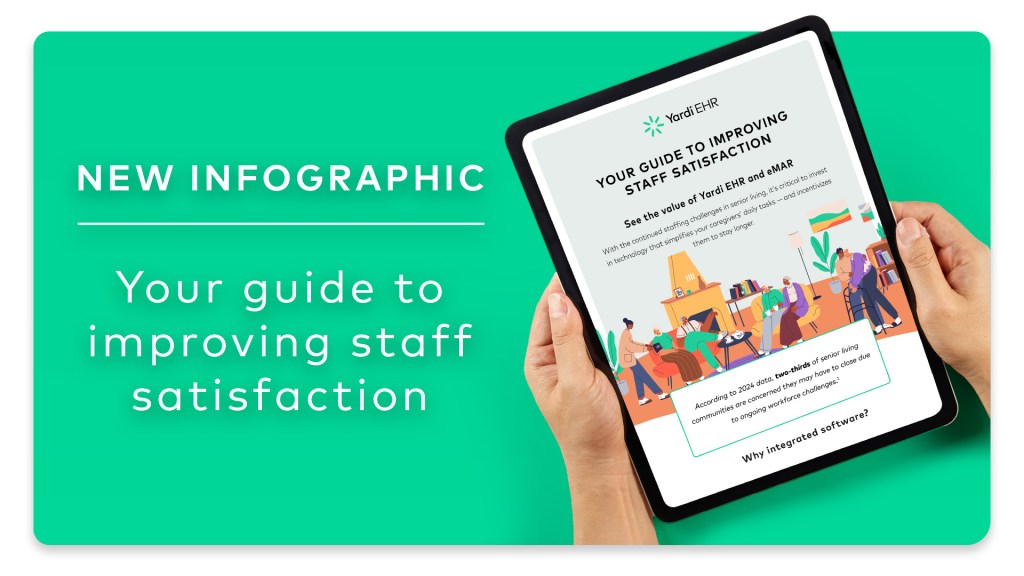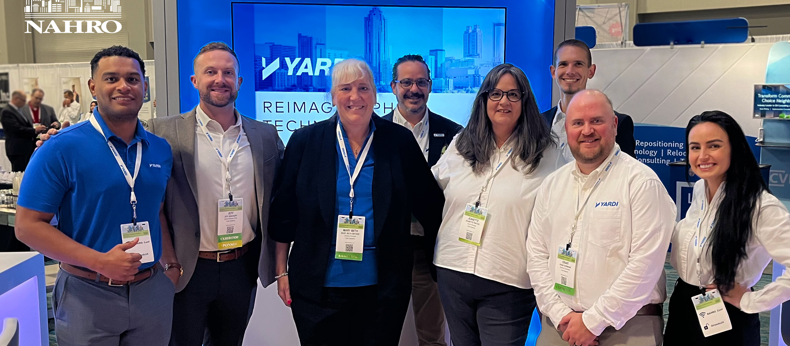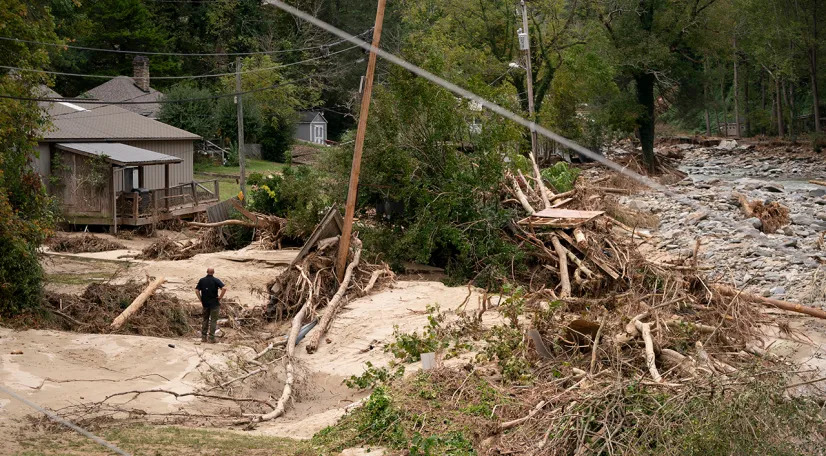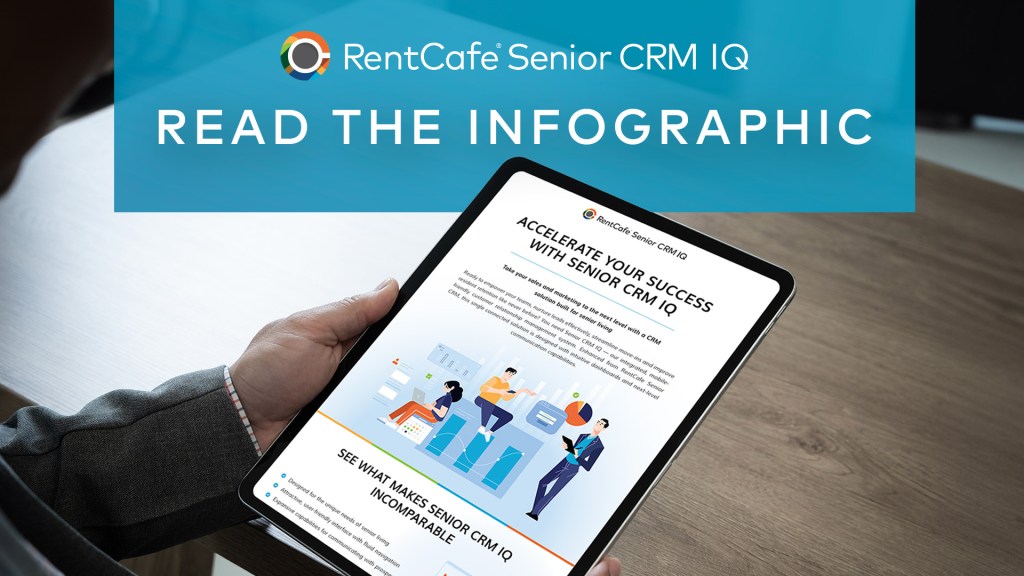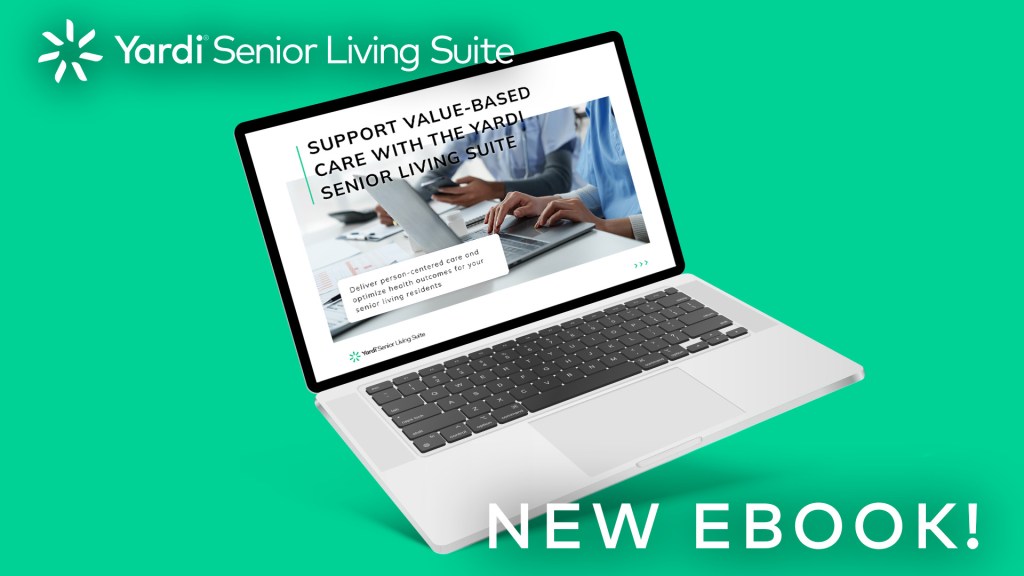With the Centers for Medicare & Medicaid Services (CMS) aiming to have 100% of Medicare and the majority of Medicaid beneficiaries tied to value-based care (VBC) by 2030, the time to implement VBC is now. Explore our new infographic to see how the Yardi Senior Living Suite helps you seamlessly deliver VBC — all from one integrated platform. See how the Yardi Senior Living Suite supports VBC Enhance communications among residents, families and the entire care team. Gather data-driven insights to identify at-risk residents and offer preventative care. Empower staff with interoperable workflows, personalized to meet resident needs. Support community wellness programs that boost resident engagement. View actionable trends to ensure comprehensive population health management. Access a digital signature workflow to enable quick adaptation of care plans. Use health care data to report on resident status during transitions of care. Participate in value-based care reimbursement models. Share a cohesive picture of resident health with physicians, health systems and more. Connect to a thriving ecosystem of monitoring and fall detection systems to supplement staff observation and reduce adverse events. Take a closer look at our fully integrated tools The Yardi Senior Living Suite combines resident care, marketing, sales, finance, business intelligence, pharmacy, operations and more on a cloud-hosted, HIPAA and SOX-compliant software platform. As it relates to VBC, you can: Enable real-time information sharing with Yardi EHR, our full-service electronic health record solution. Access clinical trends and population health with Yardi Senior IQ, our comprehensive business intelligence solution. Improve resident engagement with RentCafe Wellness, our dynamic wellness management solution. Hear from our partners “Senior living operators need tools that allow them to communicate proactively as an integrated team with care providers, patients and families to be successful in value-based care,” explained Amy Kaszak, executive vice president of strategic initiatives at Curana Health. “This means that they need technologies that integrate across the continuum and that enable workflow-based alerts and processes.” “We appreciate Yardi’s efforts to advance the technology needed to support the senior living industry’s move to value-based care,” shared Alan Fairbanks, president of the value-based care alliance at Serviam Care Network. We’re here to help Ready to chat with team Yardi? Reach out to book a meeting. We’ll share more on how our single connected solution supports...
Yardi EHR Success
Hear From Bayshore ICS
“Yardi has enhanced our interprofessional communication by providing us with a single platform to document, monitor and coordinate our interventions and care plans.” We recently interviewed Michael Peng — director of data, digital health and projects at Bayshore Integrated Care Solutions (ICS) — to get insights like the one above. Peng and his team shared how Yardi EHR (and additional solutions in the Yardi Senior Living Suite) have transformed Bayshore’s operations for the better. Read the success story to see Bayshore’s transformative journey, including where they are today. The Challenge: Inefficient Paper Processes Bayshore ICS previously used paper processes that were time consuming, susceptible to errors and difficult to maintain. Paper workflows also meant information was scattered across locations — and wasn’t easily retrievable — risking inconsistencies that could affect resident safety. Bayshore ICS sought a single connected solution that would centralize everything needed in one secure place. The Solution: Yardi EHR Yardi EHR is an integrated, interoperable electronic health record solution designed for senior living. This single connected solution combines the clinical intake process, medication management, charting, behavior management and more on a browser-based platform. The Story: Centralizing Workflows, Saving Time & Empowering Staff Before Yardi, Bayshore ICS relied on paper for charting, assessments, medication management and more, which brought an array of challenges. Not only was there a lack of standardized practices across TCU locations, but paper also made it difficult to store and retrieve information, evaluate the clinical effectiveness and complete audits. Not to mention, paper workflows posed challenges for supporting care remotely. The obstacles paper workflows created didn’t stop there. Communicating information across teams wasn’t optimal, causing staff members to feel siloed. Communication during emergency transfers was particularly inefficient since caregivers had to manually transcribe data or photocopy charts. Since...
Improve Staffing Satisfaction
With Yardi EHR & eMAR
With the continued staffing challenges in senior living, it’s critical to invest in technology that simplifies your caregivers’ daily tasks — and incentivizes them to stay longer. Explore this quick but comprehensive infographic to see exactly how technology can help you. Why integrated software? Paper processes are time-consuming and error-prone. Technology can help, but not when solutions are siloed and housed on different platforms. The burden these options create translates to staff feeling unsupported and overwhelmed, which leads to high turnover. Integrated software equips caregivers to view resident information, complete daily tasks and manage communications in one place. There’s no need to devote energy to arduous, manual administrative work, which allows them to focus on what matters most: resident care. With Yardi EHR and eMAR — fully integrated tools — you alleviate caregivers’ burden and boost satisfaction and retention. Why Yardi EHR? Gain executive health care oversight with clinical reporting, centralized resident records and instant access to financial data. View real-time health information and utilize convenient workflows, readily available at the point of care. Channel interoperability through verified interface partners that allow data to flow to and from Yardi EHR automatically. Free more time for residents with simplified record keeping, easy information sharing and reduced data-entry tasks. Utilize customizable dashboards and reports to easily manage resident care and optimize health outcomes. Access comprehensive clinical data and a staffing analysis workflow when you pair Yardi EHR with our business intelligence solution, Yardi Senior IQ. Why Yardi eMAR? Use an intuitive, customizable dashboard and workflows that adhere to state regulations and promote compliance. Reduce paper documentation, processing time and expenses with web-based records that eliminate manual medication administration tracking and medication reconciliation. Enhance care with a centralized platform for documenting vital sign data, lab orders, treatment plans and more. Incorporate automated billing based on medication orders and integrate financial analytics with medication administration. Gain a competitive edge with access to a growing market of pharmacy providers that have joined the Yardi Pharmacy Network. Eliminate discrepancies between care plans and medication administration, helping optimize staff shift assignments. Your success is our priority With Yardi, you can power your workforce strategy from a single platform. Reach out today to get...
Abandoned America
Historic - and Haunted? Ghost Towns
It’s the season to be a little spooked with thrills and shrills! Let’s explore why some cities in America have become ghost towns, and if being drawn to the mystery piques your interest, gather with some friends and uncover some real estate mysteries this fall. Many abandoned cities in America are due to the Gold Rush and industrial sites founded in the Gilded Age. Some began as lucrative mining communities that vanished almost overnight, and some are victims of new railways and infrastructure. Others were hit with natural disasters like tornados that flattened out the entire town. Hollywood movie producers and writers have been inspired and even filmed in a few. Pennsylvania. Being one of the most populous states in the country, Pennsylvania is home to many ghost towns and abandoned cities. On the western side of the state, in a suburb of Pittsburgh, Lincoln Way is an eerie little abandoned neighborhood that has become an attraction for urban explorers. Legend states that a “Beast of Lincoln Way,” a mysterious creature with glowing eyes and a haunting howl, terrorized residents, leading to the abandonment of the homes. In reality, it’s gloomier, with most residents moving away due to pollution from the emissions of the steel plant and older residents passing on. Still, many fascinating stories date back to the early 1900s, and in its final days, it is indeed an eerie, post-apocalyptic street. In eastern PA, Centralia was a thriving coal-mining town, but now, only a handful of people live there, mainly due to the coal mine that caught fire in 1962. The coal seen fueling the fire is expected to last another 250 years. This burning ghost town would not have even been recognized had it not been the inspiration for the 2006 horror...
Yardi Energy Solutions
Propelling Energy Progress
Yardi Energy Solutions is positioned to support U.S. Environmental Protection Agency initiatives in energy data aggregation, access and reporting. The agency’s new Whole-Building Energy Data Campaign, for example, is designed to help building owners appeal to utilities for access to accurate whole building data for multitenant buildings. Whole building data enables visibility into energy consumption, helping owners and managers create a roadmap for instituting ongoing operational improvements. EPA has also added data from 2022 to the ENERGY STAR Portfolio Manager Data Explorer, an interactive tool that displays performance trends of buildings benchmarked in ENERGY STAR® Portfolio Manager®. And what is Yardi Energy Solutions’ contribution? The suite of energy management solutions simplifies the collection and transfer of data to ENERGY STAR Portfolio Manager, the most widely used system in North America for compliance reporting. It also tracks building performance standards derived from ENERGY STAR data as they are developed and help clients understand and meet the associated new reporting challenges. Automation of these operations relieves building owners and managers of a difficult, time-consuming process while helping them remain compliant with any number of local and state reporting regulations. Zero building emissions standard On another front, EPA collaborated with the U.S. Department of Energy to finalize the national definition of a zero emissions building. Such a building is highly energy efficient, does not emit greenhouse gases directly from energy use and is powered solely by clean energy. According to EPA, the definition intends “to offer a standardized, consistent and measurable set of criteria for others to use in their programs and policies,” and may eventually expand beyond operational emissions to encompass embodied carbon and refrigerant management. The definition aligns closely with the criteria for EPA’s ENERGY STAR NextGen™, a certification scheduled for launch in late 2024 that will encompass superior energy performance, the use of renewable energy and means for meeting direct emissions targets. Here again, Yardi Energy Solutions can help “simplify the aggregation of whole building data collection and reporting for sustainability purposes. The first step is gathering data from multiple sources and identifying efficient and inefficient buildings,” says Joe Consolo, industry principal for Yardi Energy. Learn more about how Yardi energy management software and certified experts simplify collecting, assimilating and reporting required energy consumption...
National NAHRO Conference
Event recap
Last week, our PHA team attended the National NAHRO Conference in Orlando, Florida. We especially enjoyed the keynote speech by rapper Roxanne Shante who grew up in Queensbridge Public Housing Projects. Her story highlighted how vital safe and affordable housing is for many artists growing up. It’s inspiring to see icons like Shante actively engage with their community and use their platforms to instill change. A big thank you to our friends at NAHRO for giving us a platform to share how technology can shape the future of public housing. We find it incredibly rewarding to witness the real impact we have on our community and to engage in conversations that challenge us to think and act differently. But we didn’t just share our expertise. We also learned about the inspiring work others in the industry are doing. Our team left the conference feeling more motivated than ever to contribute to this positive change. In case you missed us, here’s a quick recap of what our team covered: Harnessing AI in public housing Jeanette Porter and Jeff Bischoff from Yardi took the stage to discuss a hot topic: AI and its potential in the public housing sector. They explored various uses of AI in housing, such as chatbots and optical character recognition (OCR). We also touched on the importance of safety and security when using AI, especially when handling sensitive personal information. “It’s critical that you have the proper plans, policies and cyber security insurance in place,” said Jeff Bischoff, director at Yardi. Looking ahead, we’re excited about using AI to simplify everyday tasks in public housing. This innovation opens a world of possibilities and we’re eager to keep the conversation going. Streamlining PHA operations with Upfront Income Verifications Next up was Mary Beth Snyder, industry principal at Yardi, who always knows how to engage the crowd and break down the complexities of income verification. Mary Beth explained the new HOTMA rules and how Level 5 Upfront Income Verification is now the highest form of verification since EIV isn’t available at move-in. She pointed out that Level 4 Tenant-Provided Verification can raise fraud concerns, while third-party verification forms have been lowered to Level 3. We also heard from Ebony Bell from the Southern Nevada Regional Housing Authority and Brandi Quiroz from the Corpus Christi Housing Authority. They discussed how their agencies handle to verification and fraud prevention, along with some strategies that have made a real difference for them. We hope to continue empowering housing authorities to streamline their verification processes and maximize staff efficiency. Final thoughts Thank you to NAHRO, Quadel and all the organizations that make this event possible. It was wonderful to see everyone come together, even during a hurricane. We’re grateful our team made it out safely, but our hearts go out to the communities affected by the storm. For more information on Yardi’s public housing solutions, please visit...
Helping After Helene
Yardi Donates to Direct Relief, World Central Kitchen to aid efforts
Photo courtesy Direct Relief On September 26, Hurricane Helene made landfall in the Big Bend area of Florida. The storm continued north and ravaged parts of Florida, Georgia, Tennessee and the Carolinas with flooding, storm surge and dangerous winds. At least 200 fatalities are confirmed as of this publication. According to the White House, up to 600 people are still unaccounted for in North Carolina. The impact on the western part of the state is profound, with millions still without power and running water. The storm is expected to be one of the costliest in United States history. After decimating 90 percent of the homes in Keaton Beach, Florida, and splintering homes in Georgia with debris-covered highways, the Carolinas and Tennessee had many strained dams and overflowing waterways, receiving over 31 inches of rain in just two days. To assist with post-hurricane relief, Yardi has pledged $250,000 to both Direct Relief and World Central Kitchen. These funds will enable both organizations to provide crucial emergency medical supplies, food, and water to those in need, demonstrating Yardi’s unwavering support for the affected communities. Sarah Bridich, Yardi’s director of corporate philanthropy, said: “With Yardi employees living in every state impacted by Hurricane Helene, we wanted to support organizations that quickly had boots on the ground. We are grateful that both Direct Relief and World Central Kitchen were able to move so quickly to provide needed medical supplies, food, and water to those directly impacted.” Direct Relief So far, Direct Relief has made available $74 million in medicines and medical supplies and $250,000 in financial assistance to community health centers, free and charitable clinics, and other healthcare partners in affected areas. According to its website, Direct Relief has staff on the ground in affected states, including Florida and Georgia, and is coordinating closely with state and national associations as well as healthcare providers to assess damages, identify priority needs, and respond to requests for emergency medical aid. As of September 30, Direct Relief had already made 14 shipments of specifically requested emergency medical aid, including antibiotics, emergency medical backpacks, DTaP vaccines, hygiene kits, rehydration salts, personal protective equipment, water purification tablets, medications and more for healthcare providers responding in Florida, North Carolina, and Tennessee. Additionally, from September 24 to October 1, Direct Relief delivered 42 shipments of essential medicines and supplies to healthcare providers in affected states as part of its Safety Net Support Program; the program seeks to ensure community health centers, free and charitable clinics, and other local healthcare providers across the U.S. have access to ongoing donations of medicines and medical supplies for their low-income and uninsured patients. World Central Kitchen World Central Kitchen (WCK) is currently operating in four states: Florida, Georgia, North Carolina, and Tennessee. This week, the organization sent five 6,200-gallon tanker trucks of fresh water to the Asheville, NC area, where it may be weeks before water supplies are running again. The trucks are capable of making multiple trips to Asheville in a 24-hour period, providing up to 100,000 gallons a day. “Fueled as always by our Chef Corps members, restaurant and food truck partners, and volunteers, WCK is working shoulder-to-shoulder with local communities to blanket the devastated region with much needed food and water aid,” said a post on the organization’s website. To help provide meals, WCK is currently partnered with 35 food trucks offering free meals: 24 in Florida, eight in Georgia, and three in Tennessee. Sixteen restaurant partners across North Carolina and Tennessee have also provided tens of thousands of hot meals and sandwiches to families in need. WCK is also using two helicopters to deliver food to those stranded when roads and bridges were destroyed. “We plan to increase hot meal distribution shortly as additional partner kitchens join the effort. Scouting operations by air and land will also remain a priority as we work to fully assess the areas hardest hit by Hurricane Helene,”...
Take Action on Energy...
Special Events in October
Coming in October: ENERGY STAR® Day (Oct. 9) and Energy Awareness Month, which offer businesses and individual consumers an array of money-saving tools and tactics. The U.S. Environmental Protection Agency, which administers ENERGY STAR, announced these designations to showcase how “using energy more wisely reduces your impact on the climate, providing a healthier and cleaner environment for all.” With ENERGY STAR, the EPA notes, “you can save today with incentives on energy-efficient products, save tomorrow with lower energy bills, and save for good for your family and the environment.” Bountiful incentives How can you use the resources highlighted during ENERGY STAR Day and Energy Awareness Month to make a meaningful difference on and off the job? Several options are available, including: Looking for the ENERGY STAR label when purchasing household products. It signifies adherence to strict energy-efficiency specification for products ranging from refrigerators, dishwashers and television sets to laptops and ceiling fans. Researching utility providers’ rebates and discounts on ENERGY STAR-certified products. Seeing if you qualify for Inflation Reduction Act income-based assistance that combines ENERGY STAR-certified products with utility rebates for home improvements. Amplifying ENERGY STAR Day themes and activities through social media and employee outreach platforms including Facebook, X, Instagram and LinkedIn. Becoming an ENERGY STAR Day participating partner with EPA, which will feature participating partners on its landing page, track all tagged social and share messages with its followers. Adopting Yardi Energy Solutions, which automates data entry into ENERGY STAR, ensures on-time reporting that keeps properties compliant with relevant regulations, reduces operational costs and more. Supporting educational and community service projects. As the recipient of the 2024 ENERGY STAR Partner of the Year award from the EPA and the U.S. Department of Energy for the sixth consecutive year since 2019, Yardi is...
Accelerate Your Success
With Senior CRM IQ
Ready to empower your teams, nurture leads effectively, streamline move-ins and improve resident retention like never before? You need RentCafe Senior CRM IQ — our integrated, mobile-friendly customer relationship management system for senior living. Enhanced from RentCafe Senior CRM, this single connected solution is designed with intuitive dashboards and next-level communication capabilities. Get the details in our brand-new infographic below. See what makes Senior CRM IQ incomparable Senior CRM IQ offers more than your average CRM solution, including: Designed for the unique needs of senior living. Attractive, user-friendly interface with fluid navigation. Expansive capabilities for communicating with prospects. Offers dashboards for managing waitlists, occupancy and more. SOX-compliant workflows that keep your data safe. Seamlessly integrates with solutions across the Yardi Senior Living Suite. Centralizes everything you need on a single platform. Comes from a Forbes Cloud 100 company with 40+ years of industry experience. Unlock unparalleled functionality When you start your journey with Senior CRM IQ, you access a comprehensive communication hub, lead stages functionality, a digital documents dashboard, customizable campaigns, electronic leasing, competitive analysis and more — all in one place. Experience the power of integration Thanks to secure integration with Yardi Senior Living Suite elements, Senior CRM IQ allows all prospect information to flow instantly between sales, finance and care staff. That means move-in proposals accurately reflect care costs — and caregivers have the information needed to serve residents best. Learn more from team Yardi Why wait to provide frictionless experiences for your sales counselors and prospective residents? Reach out today to get started with Senior CRM...
Speaking in Codes
Setting Building Standards
What are building codes and why are they necessary? Building codes are regulations that apply to architects, builders, owners and others involved in a structure’s construction and maintenance. Adopted and enforced by state, local, tribal and territorial entities, they ensure that buildings conform with safety and public health standards. They encompass standards for everything from the arrangement of doors and windows, minimum and maximum room ceiling heights, exit sizes and locations, room sizes and locations and structural integrity to lighting, water, ventilation, fire prevention and control, hazardous material handling, energy efficiency, drainage, occupancy limits, and parking and traffic impacts. Disasters spur action The Great Fire of London in 1666 prompted the first significant attempts to reduce building density and ensure that construction had some degree of fire resistance. Almost two centuries later, the London Building Act of 1855 provided the first systemic national building standard for room height, construction notifications, fireplace and drain placements and other provisions. In the U.S., building codes proliferated in the mid-19th century during heavy Industrial Revolution-inspired population growth in urban centers. Massive fires in Chicago and Baltimore in 1886 and 1904, respectively, along with the San Francisco earthquake in 1906, spurred additional codes and construction changes nationwide. Building codes are heavily influenced by the International Code Council (ICC), an association of building safety professionals whose members work with other interested parties to develop a consensus set of model codes, which are updated every three years. Policy at the local level Regardless of the recommendations the ICC might make, it is “at the state or local level whereby a building code in the US actually becomes law,” with it being common “for the final adoption authority to be left to an individual township,” according to the National Earthquake Hazards Reduction...
Apple Intelligence
Fall 2024 Edition
Apple launched and revealed its latest products last week with its latest announcement of Apple Intelligence. Let’s explore these innovative products that keep us healthy, connected, productive and entertained. Apple Watch has a new design that is even more useful, essential and intelligent. Series 10 has the most advanced design and the biggest wearable display ever built. It has 30 percent more screen area than the Series 6. With increased font size and easy type messaging, its rounded corners are softer and sleeker with a wider display and 40 percent brighter when viewed from an angle. Apple Watch Ultra 2 has new aluminum finishes and comes in Jet Black—the first ever glossy black aluminum finish, along with rose gold and silver. It is more comfortable and is the thinnest/lightest Apple Watch ever at just 9.7mm. Nearly 10 percent thinner than Series 9. A new sleek speaker lets you play music directly when you don’t have AirPods handy. Polished grade 5 titanium replaces stainless steel, weighing 20 percent less than the stainless-steel Series 9. With custom Apple silicon, it is carbon neutral and energy efficient. For phone calls on series 10, the new neural network is used to suppress background noise to make it sound clear and crisp. AirPods According to Apple, Apple AirPods are the most popular and loved headphones in the world! They are magically easy to use, and the new generation of AirPods 4 has 3D photogrammetry and laser topography to build an unparalleled data set. AirPods 4 is the most comfortable yet. It has an H2 chip unlocking only what Apple silicon can deliver—the best-sounding AirPods ever, including hands-free personalized spatial audio. When interacting with Siri, you can shake your head yes or nod to say no. Voice isolation removes all...
Connect With Us
Fall Senior Living Events
2024 fall events are right around the corner! Our senior living team looks forward to meeting with you and sharing the latest innovations with our single connected solution. See which events we’re attending below, then book time to visit us at each. NIC Fall Conference Visit us at the Woodley Park meeting room at the NIC Fall Conference — you’ll learn how our fully integrated technology helps providers unify operations and deliver quality care. We’re pleased to be an official NIC Conference partner. Book time to meet us at NIC. Event details: Marriott Marquis in Washington D.C. September 23-25, 2024 AHCA/NCAL Convention & Expo Connect with us at the AHCA/NCAL Convention & Expo to explore how the Yardi Senior Living Suite creates a foundation for success. You’ll find team Yardi at booth 2119. Schedule a meeting with us at AHCA/NCAL. Event details: Orange County Convention Center in Orlando, Florida October 6-9, 2024 SMASH 2024 Let’s network at SMASH 2024 — we’ll share how our single connected solution helps providers raise the bar. We’re happy to be a Premier Platinum sponsor. Plan time to see us at SMASH. Event details: JW Marriott Las Vegas in Las Vegas, Nevada October 14-16, 2024 LeadingAge Annual Meeting Meet with us at booth 2239 at the LeadingAge Annual Meeting. Our team will show you around the Yardi Senior Living Suite (including what’s new). Get a meeting on the books at LeadingAge. Event details: Music City Center in Nashville, Tennessee October 27-30, 2024 CALA Fall Conference & Trade Show Connect with team Yardi at booth 510 at the CALA Fall Conference & Trade Show. You’ll discover how our single connected solution offers every tool you need, all centralized in one place. We’re excited to be an Awards Luncheon sponsor. Reserve time to meet us at CALA. Event details: Renaissance Palm Springs Hotel & Palm Springs Convention Center in Palm Springs,...
Energy Efficient Fall...
Maintenance Tips
Regular maintenance in the fall can save property owners significant money and stress down the line. Here are five things to do to prevent minor problems from becoming major this season and beyond. HVAC Tune-up Preparing the HVAC system for the colder months is essential to keeping the property comfortable and energy efficient. Change air filters regularly to improve air quality and system efficiency. Clean out air ducts to ensure proper airflow. Have maintenance inspections for thermostats and upgrade to a smart programmable thermostat for better energy control during the winter. With the changing season, send email reminders to residents to keep up with the air filter changes with a quick maintenance request in their resident portal. These steps prevent potential breakdowns and improve energy efficiency, lowering utility costs and making the property more appealing to energy-conscious consumers. Roof & Gutters The roof is the first line of defense against winter weather, making fall the perfect time for any necessary maintenance. Inspect for loose or missing shingles to prevent leaks. Check chimneys, vents, and skylights to ensure the flashing is sealed correctly and free of cracks. Gutters are crucial in safeguarding the property’s foundation and roof. Clogged gutters can lead to water overflow, damaging the siding and foundation. It’s essential to clean out leaves, sticks and debris that may accumulate during the fall. Check downspouts to ensure water is being directed away from the foundation. Inspect for any gutter damage such as cracks, sagging or leaks and have maintenance repair them promptly. Regular gutter maintenance during the fall can prevent costly water damage, foundation erosion and ice dams in the winter. Weatherproofing Weatherproofing a property is not just a comfort issue. It’s also about saving on energy costs. Improve energy efficiency when a resident...
Spotlight on Affordable Housing
YASC session gives inside look
If you’ve attended a Yardi Advanced Solutions Conference (YASC), you know that Yardi addresses professionals from every property management industry segment, including affordable housing. The Affordable Housing Spotlight Session during YASC drew approximately 400 people representing providers from across the country. During the session, Yardi Director of Client Services Jackie Mills-Delling gave attendees a glimpse into Yardi’s vision for the future of affordable housing property management. Agenda items included a schedule of Yardi software releases, guidance on HOTMA implementation and solution overviews for different types of affordable housing organizations. What’s Happening with HOTMA? HOTMA stands for the Housing Opportunities Through Modernization Act of 2016. Through HOTMA, the U.S. Dept. of Housing and Urban Development is updating guidelines for several affordable housing programs that will streamline core administrative processes. Jackie provided HOTMA updates for HUD 50059, Rural Development, HOME and Low Income Tax Credit properties. The updates covered the changes that HOTMA will bring, including new forms, reports, financial calculations and more. “HOTMA has been an ongoing priority for Yardi as we work with affordable housing providers to get prepared for everything coming their way. YASC is a great opportunity to get a lot of people in the room to have a discussion of the current status of these important changes to the industry,” said Jackie. Voyager 8 Perhaps the most anticipated portion of the spotlight session was a look at Yardi’s newest version of its flagship affordable housing solution, Voyager 8. Voyager 8 includes a reimagined user interface for affordable housing professionals called Compliance Manager. YASC attendees saw a demo of Compliance Manager, many for the first time. Yardi expects to release Compliance Manager, powered by Voyager 8, in the coming months. Compliance Manager centralizes access to affordable housing data, compliance reviews, metrics, communication tools and automated income and asset verifications. With Compliance Manger, users can access each of these tools from a dashboard that does not require switching screens or logging into separate modules. “The new Compliance Manager interface will enable users to quickly see and access what they use as their daily routine. It truly is a reimagined user experience, and it’s coming soon for Yardi clients,” said Jackie. Current Yardi Voyager users will be able to access Compliance Manager at no cost and without extensive implementation efforts once they’ve migrated to Voyager 8. Solution Recommendations Another exciting portion of the spotlight session provided attendees with a look at Yardi affordable housing solutions that may be a great fit for their current and future needs. For example, the overview of Maintenance IQ showed how affordable housing providers can enhance their ability to comply with federal inspection standards “This tool has the potential to significantly enhance maintenance efficiency, reducing unit turnaround times and seamlessly integrating with procurement processes. It streamlines the integration of materials needed for tasks like changing a lock or faucet directly into the workflow,” said Jackie. Other products covered during the session included Yardi Aspire, which is a complete learning management solution, Yardi Verification Services which delivers income and asset verifications usually within a matter of minutes, Yardi Case Manager, a ticketing solution for tracking service delivery, and much more. “YASC offers a great time for our clients every year. But, beyond the fun and entertainment, there really is a focus on educating Yardi clients on our current and future solutions. There’s a lot to learn at YASC, and this affordable housing spotlight session was a great example,” said Jackie. Interested in attending a Yardi event? Check our events page for information about client events and industry tradeshows happening in the United States and Canada. If you’d like more information about Yardi affordable housing solutions, visit our website or call (800) 866-1144 to ask for an online...
Home Energy Rebates
Multifamily rebate incentives
If you’re wondering how you can get started with energy rebates, you’ve come to the right place. These incentives provide upfront savings while saving you thousands on utility costs for years to come. For example, switching from baseboard heating to a heat pump saves an average of $1,300 per year. These rebates are not just about saving money — they also create more sustainable communities while improving living conditions for low-income and disadvantaged communities. Budget season is an opportune moment to review outstanding repairs and strategize on how communities can leverage direct savings effectively. Keep reading so you’re ready to act when the time comes. The Inflation Reduction Act in a nutshell In 2022 President Joe Biden signed the Inflation Reduction Act into law, dedicating nearly $400 billion to fund clean energy and address climate issues. From this, $8.8 billion will go to Home Energy rebates, including the Home Efficiency Rebates and Home Electrification and Appliance Rebates. States are encouraged to dedicate up to 10% of rebate funding, with a $400K cap, to support upgrades in low-income, multifamily buildings. The Home Efficiency Rebates Program (Section 50121) Section 50121 awards rebates for energy efficiency improvements in residential buildings. This program is about incentivizing property managers and homeowners to make energy-saving improvements, rather than requiring full renovations and complete overhauls. By targeting improvements, such as HVAC systems, the program aims to reduce our energy consumption and utility bills. Here’s what you need to know: Eligibility: Rebates are available for energy-saving measures, such as insulation, air sealing and high-efficiency HVAC systems. Benefits for multifamily property owners: Owners can receive rebates for upgrades that reduce energy consumption — leading to lower utility bills and improved tenant satisfaction. Funding allocation: States are required to allocate a portion of the rebate funds to low-income multifamily households, ensuring broader access to energy efficiency improvements. Home Electrification and Appliance Rebates (Section 50122) Section 50122 offers rebates for qualified electrification projects for low- or moderate-income households. Electrification is crucial for transitioning homes away from carbon-powered energy. By offering rebates for qualified projects, this program encourages property managers to adopt more efficient technologies that reduce carbon footprints and improve indoor air quality. Here’s what you need to know: Eligibility: Includes rebates for electric stoves, heat pumps, water heaters and other energy-efficient appliances. Benefits for multifamily property owners: Provides direct incentives, including point-of- sales rebates of up to 100% for properties serving residents with an area median income (AMI) of 80% or lower. A portion of funds is specifically reserved for underserved communities. By upgrading to modern energy-efficient appliances, property owners can reduce utility costs and increase energy efficiency. Funding allocation: Encourages the adoption of electric appliances, contributing to the overall reduction of carbon emissions from residential buildings. Community benefit: Contributes to combatting climate change while delivering long-term savings. Electric appliances offer smart features that enhance convenience and allow users to optimize energy consumption. What does it all mean for property managers and the community? These forward-thinking incentives save costs for property managers while reducing our reliance on fossil fuels. Not to mention, updated and efficient appliances mean happier tenants. It’s a win for you, the environment and your residents. Now, let’s assess some of the key takeaways: Financial incentives: Rebates offset the cost of energy efficiency and electrification upgrades. Pass-through benefits: Property owners who receive rebates for energy efficiency and electrification improvements must pass the savings on to renters, meaning they can benefit without facing rent increases. Targeted assistance for low-income households: A significant portion of the rebate funds are allocated specifically for low-income households. This ensures that the most vulnerable have access to energy-efficient and electrified homes. Tenant notification and consent: Property owners may be required to notify tenants about planned improvements and obtain their consent, particularly when the upgrades involve entering rental units. This ensures transparency and respect for renters’ rights and privacy. Affordability: Programs often include...
Support Value-Based Care
With Senior Living Technology
Looking to advance value-based care (VBC) in your senior living communities but not sure how to get there? Our fully integrated solution — the Yardi Senior Living Suite — is built to help. To give you a better understanding of how VBC works (and how our technology can support you) we created an informative new ebook. Don’t miss the insights shared — get a highlight below then explore the full ebook. What is value-based care? VBC focuses on the quality of care and the resident experience. More specifically, enhancing the resident experience through proactive, personalized and person-centered care. In today’s senior living communities, providing VBC can drastically improve resident health outcomes and increase operational returns. How does our technology support VBC? The Yardi Senior Living Suite combines resident care, marketing, sales, finance, business intelligence, pharmacy, operations and more on a cloud-hosted, HIPAA and SOX-compliant software platform. The suite of products is single-stack — uniting on a fully integrated platform — and offers intuitive functionality that helps you provide the best care and improve health outcomes across your communities. Taking a closer look, our single connected solution supports VBC by: Enhancing communications among residents, families and the entire care team. Providing data-driven insights for identifying at-risk residents, proactively mitigating issues and offering preventative care. Empowering staff with interoperable workflows, personalized to meet resident needs. Supporting community wellness programs and boosting resident engagement. Ensuring comprehensive population health management thanks to actionable information and trends. Offering a digital signature workflow that enables quick adaptation of care plans as resident needs change. Presenting health care data that’s pulled into the clinical intake, equipping you to report on resident status during transitions of care. Enabling value-based care reimbursement models. Centralizing data in one secure place, sharing a cohesive picture of resident health with physicians, health systems and more. Explore our single-stack solution for VBC Yardi EHR: Yardi EHR is a full-service electronic health record solution that unites clinical intake processing, medication management, resident assessments, interoperability, care planning and more. It enables streamlined analysis of population health metrics and real-time information sharing — helping you track and improve resident health outcomes. Senior IQ: Senior IQ is a dynamic business intelligence solution that presents real-time, community-specific data in sharable dashboards. You have the power to analyze actionable information and identify trends — helping you predict resident health outcomes and adjust care plans accordingly. RentCafe Wellness: RentCafe Wellness is a comprehensive community wellness solution that enables you to schedule activities, share information via online calendars, track resident attendance and more. By supporting resident engagement and providing families with access to wellness information, you reduce the risk of isolation — optimizing resident health outcomes. Read the ebook in full The Yardi Senior Living Suite offers more tools built to support VBC — read the ebook in its entirety to learn more. And if you have any questions for our team, don’t hesitate to reach...
Look Out Below
Managing Sinkholes
One of them, measuring 100 feet wide and 50 feet deep, opened up at the center of a soccer complex in Alton, Ill., taking down a light pole, benches and artificial turf. Another one in Madera, Calif., consumed a truck trailer. Others forming in front yards in Highland City, Fla., and Las Cruces, N.M., swallowed vehicles and forced residents to evacuate their homes. These are a few of the sinkholes that have been reported in the U.S. just this year. Sinkholes occur when depressions in the ground have no natural external surface drainage, so when it rains, the water remains inside the sinkhole. Over time, the water erodes underlying soluble rocks such as gypsum or limestone, creating underground spaces and caverns. When the underground space becomes too big to support the land above it, the land surface collapses. They typically vary from about three to 165 feet deep. The largest recorded U.S. sinkhole, in central Alabama, formed in 1972 and measures about 325 feet long, 300 feet wide and 120 feet deep. While sinkholes are a natural phenomenon, human activity such as groundwater pumping, soil removal, drilling, and construction of dams and other water impoundments can weaken underlying rock and accelerate their development. Damage caused by sinkholes totals at least $300 million annually, according to the U.S. Geological Survey. Many sinkhole collapses go unobserved in remote areas or are not reported to authorities. Rare but meriting attention Signs of potential sinkholes include slumping or falling trees or fence posts, plants that die as their water is drawn away, interrupted utility services and a circular pattern of ground cracks. While sinkholes can be ominous, they are “blessedly rare,” engulfing only a few of the more than 140 million housing units in the U.S. every year. A...
Inspiring Generations
National Assisted Living Week
It’s time for this year’s National Assisted Living Week (NALW), an annual recognition of assisted living communities and the individuals they serve. NALW was established by the National Center for Assisted Living (NCAL) in 1995 and each year, a special theme is announced. The 2024 theme — Inspiring Generations — encourages senior living staff, residents and families to share stories and wisdom with one another. We’ll share more on this year’s observance below, covering how our senior living clients are participating. Happy #NALW! Learn about National Assisted Living Week NALW seeks to recognize assisted living communities and highlight the important role they play. Specifically, their role in caring for America’s seniors and individuals with disabilities. The 2024 observance encourages communities around the country to offer events in honor of NALW — and to educate the public about the importance of long-term care. Fortunately, NCAL provides a thorough planning guide each year to help communities drive these events forward. Check out the 2024 planning guide from NCAL! See how Yardi clients celebrated this year Pacifica Senior Living took to social media to spotlight NALW, including an announcement post shining light on the joys of community living. Pacifica also shared posts celebrating individual communities — complete with heartwarming photos — including Pacifica Encinitas, West Park and San Leandro. At Benchmark Senior Living, a celebratory blog post was dedicated to NALW (plus a LinkedIn post sharing a snapshot). The blog post honors this year’s NALW theme with inspiring stories from Benchmark communities, all focused on residents. Maplewood Senior Living also posted on LinkedIn for NALW, sharing a strong message: associates are the heart of Maplewood communities, and their devotion to residents deserves recognition. “This week, we celebrate the exceptional dedication and compassion of our associates who make every community a vibrant, caring place for our residents,” shared Maplewood in the post. For Vitality Living, NALW is all about honoring the incredible bonds formed between residents, team members and volunteers. Their social media post encourages other communities to celebrate the connections they share — and notes appreciation for individuals across Vitality communities. Join the 2024 observance It’s never too late to celebrate assisted living communities and the residents they serve. Join the cause by reading more on National Assisted Living Week — and share your own stories on social media with the hashtag...
Pressure Test
High-Rise Water Infrastructure
As you admire the expansive view or plush furnishings from the highest reaches of a commercial, residential or other type of building, it’s easy to take some things for granted – such as the system that distributes water for drinking, removing waste and suppressing fire. How does water arrive ready for use at the highest levels of a structure? Plumbing systems must be capable of supplying water from municipal or private sources at a consistent pressure, volume and temperature to high-rise buildings, which are anywhere from 75 feet to more than 2,000 feet. Some principal challenges of high-rise water distribution center around controlling pressure, which is “both friend and foe in plumbing systems,” say experts at the Nagpur Priyadarshini Indira Gandhi College of Engineering in Maharashtra, India. Water pressure systems that accommodate everything from low-flow faucet to high-flow showers and fire sprinklers must be carefully regulated to ensure efficient delivery and protect the building’s infrastructure. Other complications arise from the multiple penetrations through structural slabs that are needed to install plumbing infrastructure. Each of them must be sealed to prevent vertical migration of fire and smoke. Tall buildings require more robust structures, further limiting the allowable space for penetrations. Building designers and operators must also take water treatment systems and backup pumps and tanks to prevent service disruptions into consideration. And buildings such as hospitals must accommodate specialized plumbing needs such as laboratory waste, medical gases, and multiple water temperatures for cleaning and sanitizing. The water distribution system in a high-rise building can vary depending on the building’s size, number of occupants and local building codes and regulations. The two basic methods for distributing water are: Rooftop reservoir. After water is pumped to a rooftop reservoir, gravity distributes it throughout the floors below. “It’s...
School Money Rules
HS Financial Education Expands
The traditional core curriculum for K-12 education comprises “reading, writing and arithmetic,” with science, the arts and health also maintaining a presence. Happy African American student raising her hand to ask a question during lecture in the classroom. Another concentration is joining this essential group: personal finances, a subject that encompasses such concepts as maintaining bank accounts, paying bills on time, creating a household budget, saving for retirement and understanding borrowing rates. Twenty-six U.S. states require or will require high school financial education; personal finance education bills are pending in another 15 states. A new law in California, for example, requires a semester-long personal finance education course to be available for all high school students by the 2027-28 school year, with personal finance a graduation requirement starting with the 2030-31 graduating class. Crucial skills to ‘play the money game’ A growing understanding of the connection between teen comprehension and adult quality of life is driving the surge in early financial education. “When you learn how money works at a young age, you’ll have the necessary skills to make positive financial decisions as an adult. When you’re financially literate, you’re better able to manage the ups and downs of life as they happen — your physical health, mental health and relationships will be better off as a result,” Joe Camberato, CEO and founder of small business loan provider National Business Capital, wrote in Forbes magazine in 2022. Carly Urban, economics professor at Montana State University and a financial literacy expert, says that high school financial instruction has been shown to improve credit scores, lower loan delinquency rates and reduce the accumulation of credit card debt. It also helps position young people to make informed decisions about college loan types and repayment obligations while providing a...

